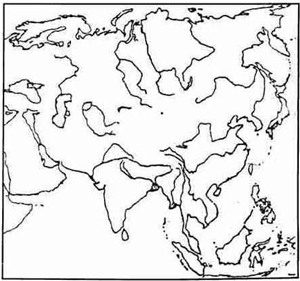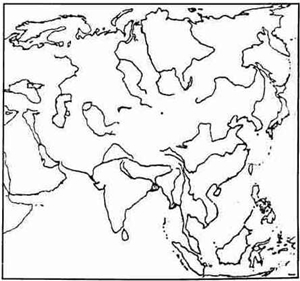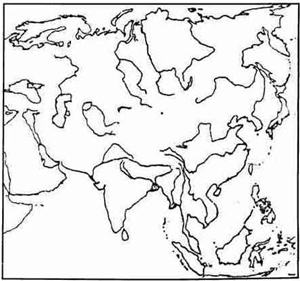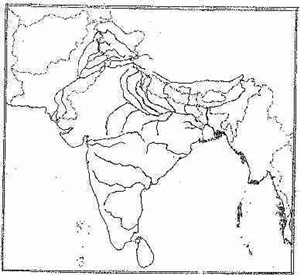(Geography) ICSE Class X Important Questions : Geography (1996)
Disclaimer: This website is NOT associated with CBSE, for official website of CBSE visit - www.cbse.gov.in
Paper : ICSE Class X Important Questions : Geography (1996)
General Instructins
-
Section A is compulsory. All questions from Section A are to be attempted.
-
Answer any two questions from Section B,answer any two questionsfrom Section C and Section D. The intended marks for questions or parts of questions are given in brackets.
SECTION
- A
Attempt all questions from this Section.
Question 1
(a) [5]
-
Name the largest settlement shown on the map, and mention the special communication facility it enjoys unlike other villages in the map.
-
What is the dominant mode of transport all over the region? Draw the coloured symbol used for the same.
-
In view of the domination of the yellow colour on the map, what do you think must be the major occupation of the people?
(b) [5]
-
What is the principal means of irrigation used in the region? Draw the conventional coloured symbol used on the map.
-
What is the nature of streams and tanks spread over the region? In what quarter of the map do you notice the broken ground along the banks of the streams?
-
What kind of climate do you infer from the nature of streams and tanks present in the region?
(c) [5]
-
Towards what direction is the general slope of the land? What immediately suggests to you that it is so?
-
What is meant by contour interval? How much is it in the case of this map?
-
Give just one word for the following lengthy statement : "The ratio which a distance between any two points on a map bears to the actual distance between the corresponding points on the ground.
(d) [5]
-
What is the total area of the actual ground represented on your map? Show the calculation you have made.
-
Give four-figure grid references of HAMIRPURA (lying on the Western margin of the map) and DADARLA (on the Eastern).
-
Give six-figure grid reference of the spot-height 229 lying close to the northern margin of the map.
Question 2
On an outline map of Asia provided:

(a) Mark and label the Ural Mountains. [1]
(b) Shade and label the Tibetan Plateau. [1]
(c) Shade and label the Indus Plains. [1]
(d) Mark and label the Pamir Knot. [1]
(e) Shade and label the Tarim Basin. [1]
(f) Shade and label the Shan Plateau. [1]
(g) Mark and label the Hindukush Mountains. [1]
(h) Shade and label the Northern Lowlands. [1]
(i) Mark and label the Tian Shan Mountains. [1]
(j) Shade and mark the Iranian Plateau. [1]
Question 3
On an outline map of Asia provided:

(a) Shade and label the Caspian Sea. [1]
(b) Mark and label the Mekong River. [1]
(c) Shade and label the Archipelago of Philippines. [1]
(d) Shade and label the Arabian Sea. [1]
(e) Mark and label the Amur River. [1]
(f) Shade and label the Sea of Japan. [1]
(g) Mark and label the River Tigris. [1]
(h) Shade and label the Black Sea. [1]
(i) Mark and label the River Yangtze. [1]
(j) Mark and label the River Yenisey. [1]
Question 4
On an outline map of Asia provided:

(a) The Asian Tundra. [1]
(b) The Japanese Arch-ipelago. [1]
(c) The Monsoon lands of South Asia. [1]
(d) The Asian Taiga. [1]
(e) The Equatorial Asia. [1]
(f) The Desert in Saudi Arabia. [1]
(g) Western Malaysia. [1]
(h) Myanmar. [1]
(i) Korean Peninsula. [1]
(j) Vietnam. [1]
SECTION - C
Attempt any two questions from this Section.
Question 5
On an outline map of the Indian sub-continent provided:

(a) Mark and label the port city of Pakistan. [1]
(b) Shade and label the Rann of Kutchh. [1]
(c) Shade and label the major jute producing area of the Indian sub-continent. [1]
(d) Mark and label the River Narmada. [1]
(e) Mark and write the name of the 'Commercial Capital' of India. [1]
(f) Mark and label the Nilgiris. [1]
(g) Shade and label the thickly populated state of India with almost universal literacy. [1]
(h) Shade and label the large valley known for its tea garden. [1]
(i) Mark and label the Bombay High. [1]
(j) Mark and Label the River Yamuna. [1]
Question 6
(a) State the value of the angle which the standard Meridian of India makes with the Prime Meridian. Show, by calculations, the time lag between I.S.T. and G.M.T. [2]
(b) By what name is the parallel of latitude 23° 30' N known? Name the zones or belts into which it divides India almost equally. [2]
(c) How are the sources of rainfall in the North-West part of India different from the rainfall experienced on the coastal areas of Eastern India in winter? [2]
(d) (i) What is meant by a "Rain Shadow" area? [1]
(ii) Give two examples of 'Rain Shadow' areas in India. [1]
(e) Give two reasons as to why the Thar is a desert area. [2]
Question 7
(a) Name the four major soil types found in India, leaving out desert and mountain soils. [2]
(b) Name the soil known for its self-ploughing quality and the capacity to hold moisture. Name two cash crops for which it is specially suited. [2]
(c) Name the transported soil most widely found in India. State the two sub-categories into which it is generally divided. What are their local names and which one of them is superior to the other? [2]
(d) Give a single word for each of the following:
-
"The loose rock material, together with humus, forming the uppermost layer of the earth's crust and serving as a source of food and moisture for plants." [1]
-
"The process of percolation by which valuable mineral nutrients are washed down from the top layer of the soil only to deposit them in the lower layers, making thereby the top soil infertile." [1]
(e) How are the laterite soils formed and where are they found in India? [2]
SECTION - D
Attempt any two questions from this Section.
Question 8
(a) What are the climatic requirements of rubber plantations in terms of: [2]
-
Mean annual temperatures;
-
Minimum temperature.
-
Amount of rainfall; and
-
Rairnall regime?
(b) Which is the most important and widespread fibre crop of India? What kind of soil is traditionally suited to this crop and why? [2]
(c) State the leading beverage crop of India. What are its requirements in terms of soil rainfall and labour? [2]
(d) Name the state where rice is grown almost exclusively as a cash crop. What makes rice the staple food crop of India? [2]
(e) Which are the two most important oilseed crops of India? State the crop season and the major areas in which each one of them is grown. [2]
Question 9
(a) Name two textile industries using animal flares and another two, usin plant fibres. Write against each one of them an important centre of the respective industry. [4]
(b) Name the oldest oil refinery in India alongwith the name of the state in which it is located. State two new refineries one from Gujarat and the other from Uttar Pradesh. [2]
(c) What two advantages does the Vishakhapatnam steel plant has over the other steel plants in the public sector? [2]
(d) What makes Khadi and Handloom sector of the textiles industry still very important in this modern large-scale industrial era? Give two reasons to justify your answer. [2]
Question 10
(a) Distinguish between: [2]
-
Inundation Canals and Perennial Canals.
-
A Dam and A Barrage.
(b) Which was the first multipurpose project completed in India? Mention its two beneficiary states. [2]
(c) State how tube-well irrigation scores over canal irrigation in two different ways. [2]
(d) Name the multi-purpose project and the state in which it is located in respect of- (i) Mahanadi, and (ii) Sutlej. [2]
(e) Mention the most abundant non-conventional source of energy. Furnish two examples of its indirect and direct uses. [2]